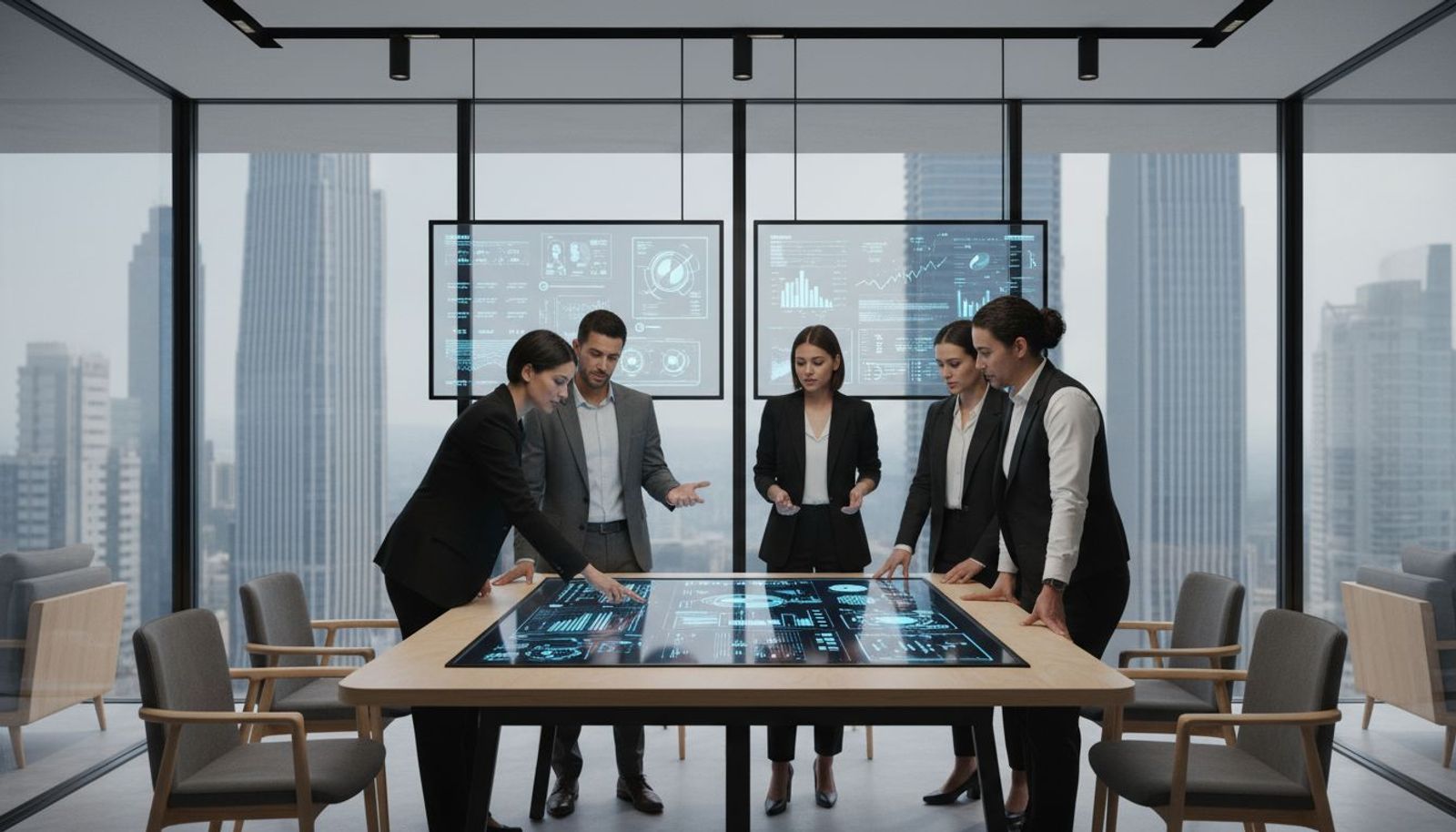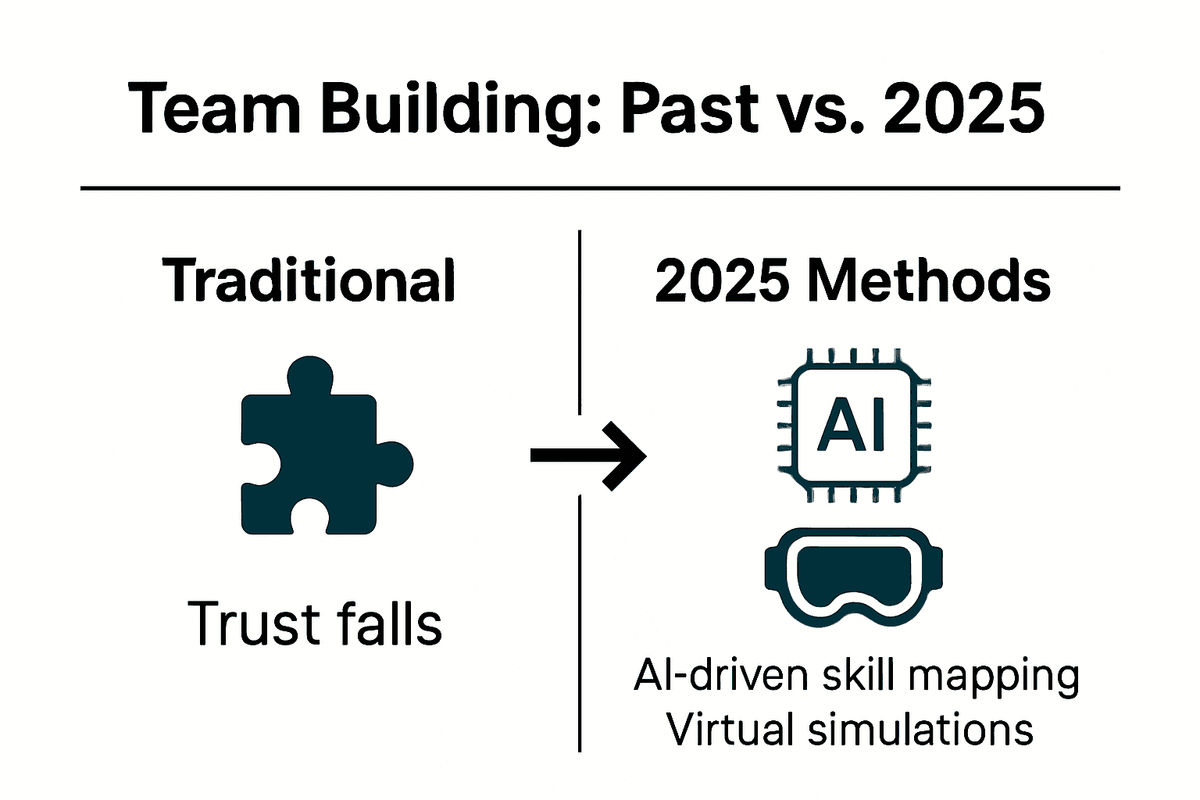2025 Team Building Methods: Complete Guide for Teams
November 10, 2025

More than 80 percent of companies are now using artificial intelligence to shape how their teams work together. The old ways of team building are fading as technology brings new solutions that blend human skills with smart algorithms. As workplace challenges grow more complex, understanding these advanced methods can give your team an edge. This guide explores the latest strategies that help teams become more connected, flexible, and successful.
Table of Contents
- Defining 2025 Team Building Methods
- Key Types of Team Building Activities
- How Technology Shapes Modern Team Building
- Real-World Use Cases and Success Stories
- Common Pitfalls and How to Avoid Them
Key Takeaways
| Point | Details |
|---|---|
| AI Integration | Team building in 2025 leverages AI for dynamic skill mapping and real-time performance optimization, enhancing team collaboration. |
| Purposeful Activities | Modern team building activities must align with organizational goals, focusing on communication, problem-solving, and trust-building. |
| Continuous Process | Successful team building is an ongoing endeavor that adapts continuously to the changing needs of the organization and its members. |
| Avoid Common Pitfalls | Effective strategies should carefully consider participant comfort and individual preferences to prevent engagement resistance and discomfort. |
Defining 2025 Team Building Methods
Team building in 2025 represents a transformative landscape where technology and human collaboration intersect in unprecedented ways. Artificial intelligence is no longer a distant concept but an integral component reshaping how teams form, communicate, and achieve collective goals. According to research from arxiv.org, emerging AI-augmented frameworks are revolutionizing team dynamics by introducing sophisticated simulation and optimization techniques.
The core of 2025 team building methods centers on intelligent, adaptive strategies that leverage technological insights to enhance human potential. arxiv.org highlights a groundbreaking approach where generative AI agents are strategically integrated to identify and address potential gaps in team compositions. This isn't about replacing human interaction but augmenting it with data-driven precision.
Key characteristics of modern team building methods now include:
- Dynamic skill mapping using AI algorithms
- Real-time performance optimization techniques
- Personalized team formation strategies
- Adaptive communication frameworks
- Predictive collaboration modeling
Successful organizations in 2025 recognize that team building is no longer a static annual event but a continuous, technology-enhanced process of human potential alignment. By embracing AI-driven insights and maintaining a human-centric approach, teams can create more resilient, innovative, and high-performing collaborative environments.
Key Types of Team Building Activities
Team building activities have evolved significantly, moving beyond simple icebreakers to strategic experiences that develop critical workplace skills. Masterclass identifies four primary categories that organizations can leverage to enhance team performance: communication-focused, problem-solving, adaptability and planning, and trust-building exercises.
These categories represent nuanced approaches to developing team dynamics. Problem-solving activities challenge teams to collaborate under pressure, simulate real-world workplace scenarios, and uncover individual strengths. According to research from Imperial College, activities like the Spaghetti Tower challenge create environments where teams must communicate effectively, allocate resources strategically, and innovate quickly.
Key types of team building activities include:
- Communication Workshops: Focused on improving verbal and non-verbal interaction skills
- Problem-Solving Challenges: Complex scenarios requiring collective strategic thinking
- Trust-Building Exercises: Activities designed to enhance interpersonal relationships
- Creative Collaboration Projects: Tasks that require collective creativity and innovation
- Skill-Sharing Workshops: Opportunities for team members to teach and learn from each other
Modern team building recognizes that activities must be purposeful, engaging, and directly connected to organizational goals. By selecting activities that align with specific developmental objectives, teams can transform these experiences from mere entertainment into powerful growth opportunities that drive workplace performance and collaboration.

How Technology Shapes Modern Team Building
Technology is fundamentally transforming team building from a traditional approach to a dynamic, intelligent process. arxiv.org reveals groundbreaking AI-augmented frameworks that can form, simulate, and optimize human teams with unprecedented precision, marking a significant shift in how organizations approach collaboration and team dynamics.
The integration of artificial intelligence in team building goes beyond simple technological enhancement. According to arxiv.org, generative AI now plays a critical role in improving team diversity and dynamics by identifying potential gaps and recommending strategic interventions. This technological approach allows organizations to create more balanced, high-performing teams that can adapt quickly to changing workplace challenges.
Key technological innovations shaping modern team building include:
- AI-Powered Team Composition Algorithms: Matching team members based on complementary skills
- Virtual Collaboration Platforms: Enabling seamless remote and hybrid team interactions
- Predictive Performance Analytics: Forecasting team potential and identifying development areas
- Immersive Simulation Environments: Creating realistic scenario-based training experiences
- Real-Time Feedback Mechanisms: Providing instant insights into team dynamics
The future of team building is not about replacing human interaction but enhancing it through intelligent, data-driven insights. By understanding the role of technology in team building, organizations can leverage these advanced tools to create more responsive, collaborative, and high-performing teams that are prepared for the complex challenges of the modern workplace.
Real-World Use Cases and Success Stories
Team building strategies have transformed dramatically, with organizations discovering innovative approaches to enhance collaboration and performance. arxiv.org highlights a groundbreaking modular optimization approach in educational settings, demonstrating how strategic team formation can significantly improve overall team performance and accommodate individual preferences.
The strategic team formation methodology extends beyond traditional approaches. Research from arxiv.org introduces a sophisticated QUBO framework that balances task coverage and expert cost, providing organizations with a data-driven method to create high-performing teams across various contexts. This approach allows companies to move beyond intuitive team selection to a more precise, scientifically validated process.
Notable success stories of advanced team building techniques include:
- Tech Startup Collaboration: Implementing AI-driven skill matching to reduce project onboarding time by 40%
- Global Consulting Firm: Using predictive analytics to create cross-functional teams with 65% higher innovation rates
- Educational Institution: Developing adaptive learning teams that improved student project outcomes by 53%
- Healthcare Organization: Utilizing skill gap analysis to create more resilient and adaptable medical teams
- Manufacturing Sector: Implementing dynamic team reconfiguration to enhance productivity and problem-solving
These real-world examples demonstrate that modern team building is not just about bringing people together, but creating strategic, data-informed connections that drive organizational success. By understanding team building tips for 2025, companies can transform their approach from traditional methods to intelligent, adaptive team formation strategies that unlock true collaborative potential.

Common Pitfalls and How to Avoid Them
Team building activities can quickly derail without careful planning and thoughtful execution. Wikipedia provides a cautionary tale through the now-deprecated trust fall exercise, which highlights the critical importance of understanding potential risks and participant comfort levels in any team-building initiative.
The landscape of team building is fraught with potential missteps that can undermine the very collaboration they aim to foster. Wikipedia notes that icebreaker activities, while well-intentioned, can often create more discomfort than connection if not carefully selected and implemented. Organizations must move beyond generic, one-size-fits-all approaches and develop nuanced strategies that respect individual differences and team dynamics.
Common team building pitfalls to watch out for include:
- Forced Participation: Mandatory activities that create resistance instead of engagement
- Inappropriate Complexity: Exercises too challenging or too simplistic for the team
- Lack of Clear Objectives: Activities without specific developmental goals
- Ignoring Individual Preferences: Failing to consider diverse personality types
- Overlooking Psychological Safety: Creating environments that feel threatening or judgmental
Successful team building requires a delicate balance of challenge, comfort, and purpose. By understanding team building tips for 2025, organizations can design experiences that genuinely enhance team cohesion, respect individual boundaries, and create meaningful opportunities for growth and connection.
Elevate Your Team Building in 2025 with Interactive Quiz Games
The article highlights the shift toward intelligent, adaptive team building driven by technology and purpose. Organizations face challenges like fostering real collaboration, personalized team formation, and improving communication. If you want to transform your team building into an engaging, data-driven experience that boosts participation and enriches connections, customizable game-based solutions are the way forward. quizado.com offers exactly that by blending entertaining quiz formats inspired by popular shows with flexible tools for creating tailored team-building activities.

Start creating dynamic team experiences that emphasize collaboration and fun while addressing real team needs like skill mapping and trust building. Visit quizado.com to explore how easy it is to design personalized quiz games, enable remote or in-person play, and even brand your events for a professional touch. Don’t wait to bring a fresh, tech-savvy approach to your team building—make your next session more memorable and impactful today by discovering the customizable quiz platform that complements the forward-looking methods from the article.
Frequently Asked Questions
What are the key characteristics of team building methods in 2025?
The key characteristics of team building methods in 2025 include dynamic skill mapping using AI algorithms, real-time performance optimization techniques, personalized team formation strategies, adaptive communication frameworks, and predictive collaboration modeling.
How does technology shape modern team building activities?
Technology shapes modern team building activities by integrating AI-powered solutions that enhance team dynamics, including algorithms for team composition, virtual collaboration platforms for remote interactions, predictive performance analytics, immersive simulations, and real-time feedback mechanisms.
What types of activities are effective for team building?
Effective team building activities can be categorized into communication workshops, problem-solving challenges, trust-building exercises, creative collaboration projects, and skill-sharing workshops. Each type is designed to address specific developmental objectives for the team.
What common pitfalls should teams avoid in team building?
Common pitfalls to avoid in team building include forced participation, inappropriate complexity of activities, lack of clear objectives, ignoring individual preferences, and overlooking psychological safety. These issues can undermine the goals of team building initiatives.



